Importance of Clinical Communication and Documentation in ED
VerifiedAdded on 2022/11/25
|7
|1625
|173
Report
AI Summary
This report explores the critical aspects of clinical communication and documentation within the emergency department (ED). It highlights issues experienced by both patients and registered nurses, emphasizing the importance of patient autonomy and the impact of effective communication on patient satisfaction and compliance with medical recommendations. The report also addresses the legal responsibilities of healthcare professionals regarding information provision and documentation. Furthermore, it discusses proposals for effective communication and documentation, including the use of clear medical terminology, the cultivation of compassionate care, and the implementation of structured handover processes. The importance of electronic medical records for accurate record-keeping and patient safety is also emphasized. The report draws on various research studies and emphasizes the need for continuous improvement in communication and documentation practices to ensure quality healthcare delivery in the ED.
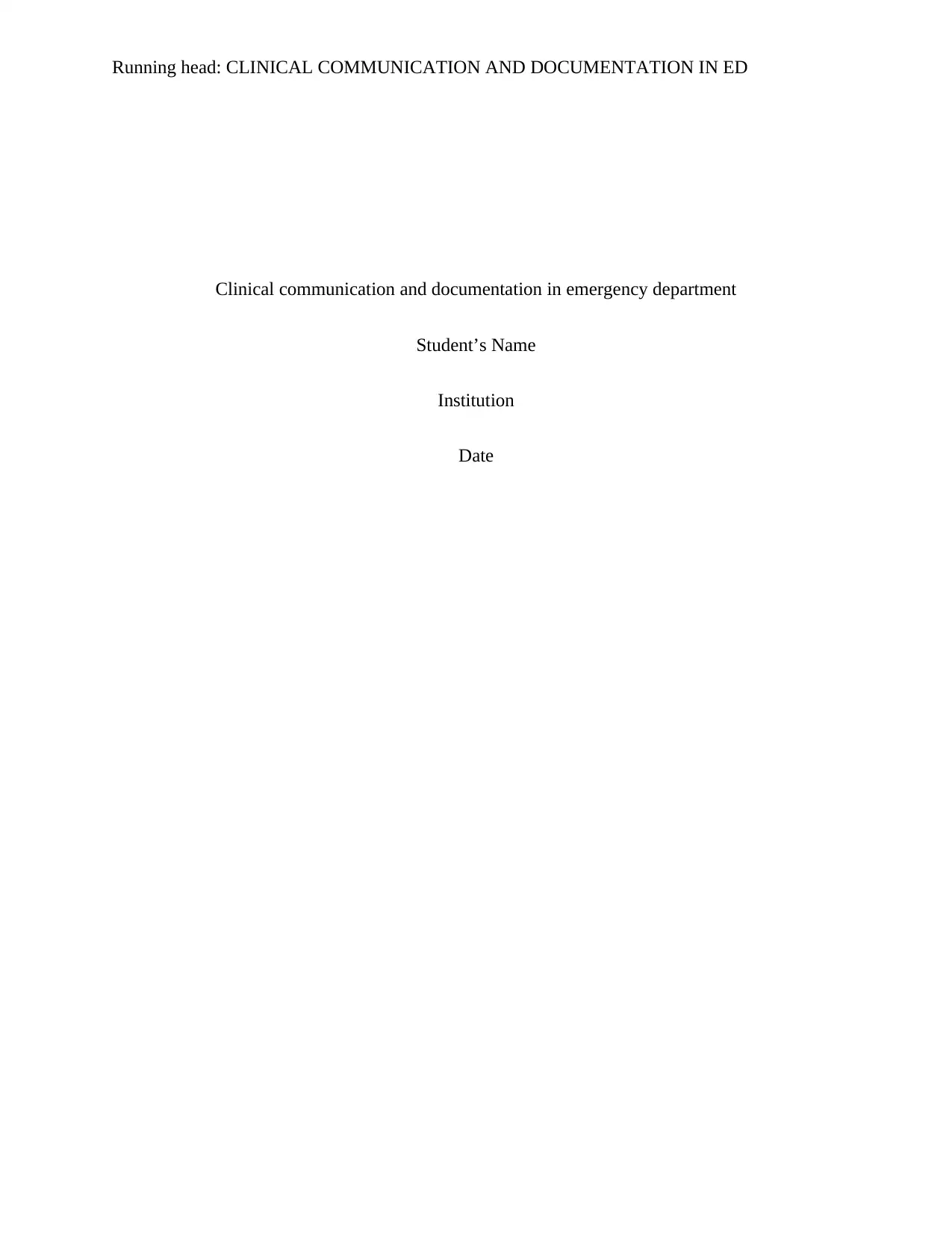
Running head: CLINICAL COMMUNICATION AND DOCUMENTATION IN ED
Clinical communication and documentation in emergency department
Student’s Name
Institution
Date
Clinical communication and documentation in emergency department
Student’s Name
Institution
Date
Paraphrase This Document
Need a fresh take? Get an instant paraphrase of this document with our AI Paraphraser
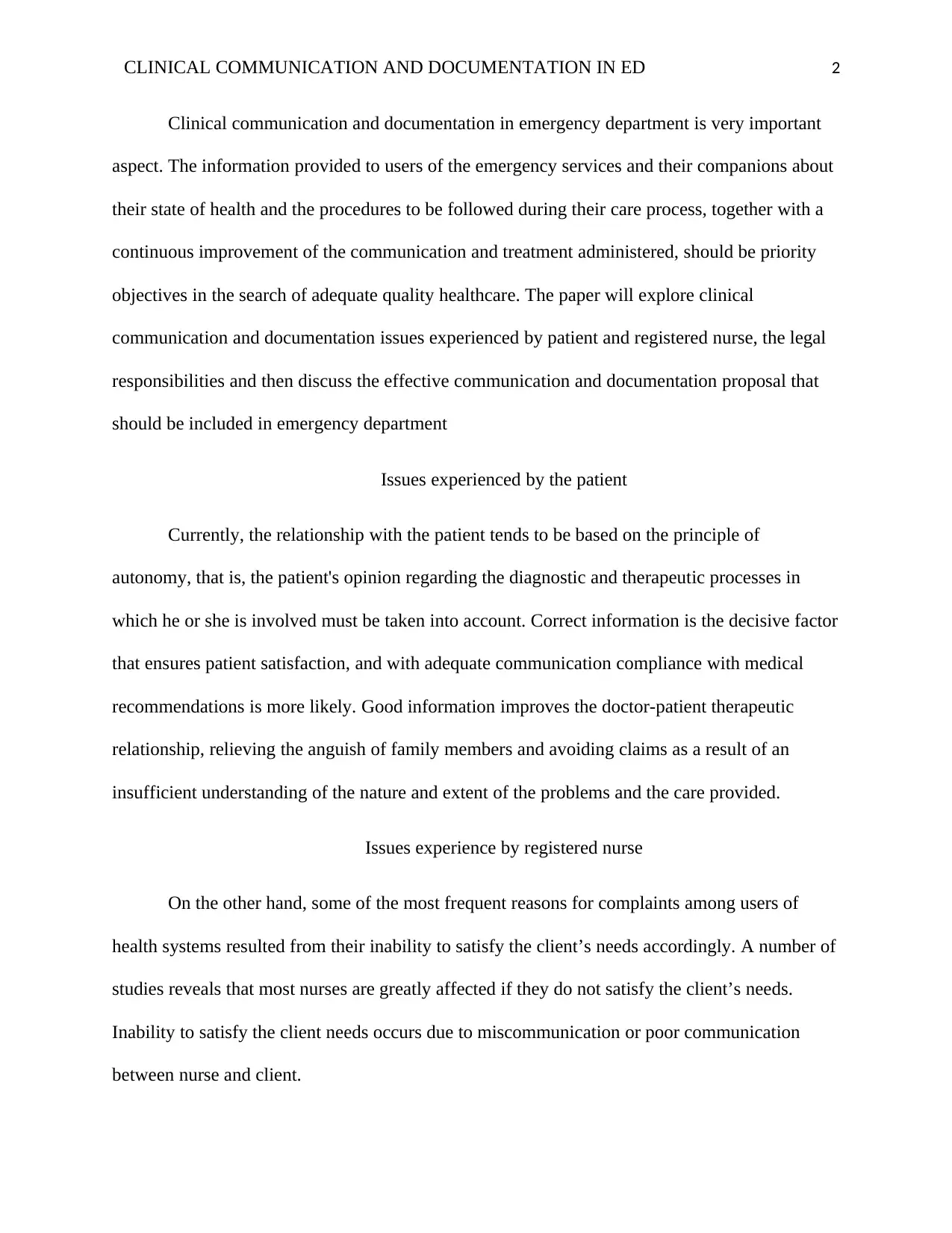
CLINICAL COMMUNICATION AND DOCUMENTATION IN ED 2
Clinical communication and documentation in emergency department is very important
aspect. The information provided to users of the emergency services and their companions about
their state of health and the procedures to be followed during their care process, together with a
continuous improvement of the communication and treatment administered, should be priority
objectives in the search of adequate quality healthcare. The paper will explore clinical
communication and documentation issues experienced by patient and registered nurse, the legal
responsibilities and then discuss the effective communication and documentation proposal that
should be included in emergency department
Issues experienced by the patient
Currently, the relationship with the patient tends to be based on the principle of
autonomy, that is, the patient's opinion regarding the diagnostic and therapeutic processes in
which he or she is involved must be taken into account. Correct information is the decisive factor
that ensures patient satisfaction, and with adequate communication compliance with medical
recommendations is more likely. Good information improves the doctor-patient therapeutic
relationship, relieving the anguish of family members and avoiding claims as a result of an
insufficient understanding of the nature and extent of the problems and the care provided.
Issues experience by registered nurse
On the other hand, some of the most frequent reasons for complaints among users of
health systems resulted from their inability to satisfy the client’s needs accordingly. A number of
studies reveals that most nurses are greatly affected if they do not satisfy the client’s needs.
Inability to satisfy the client needs occurs due to miscommunication or poor communication
between nurse and client.
Clinical communication and documentation in emergency department is very important
aspect. The information provided to users of the emergency services and their companions about
their state of health and the procedures to be followed during their care process, together with a
continuous improvement of the communication and treatment administered, should be priority
objectives in the search of adequate quality healthcare. The paper will explore clinical
communication and documentation issues experienced by patient and registered nurse, the legal
responsibilities and then discuss the effective communication and documentation proposal that
should be included in emergency department
Issues experienced by the patient
Currently, the relationship with the patient tends to be based on the principle of
autonomy, that is, the patient's opinion regarding the diagnostic and therapeutic processes in
which he or she is involved must be taken into account. Correct information is the decisive factor
that ensures patient satisfaction, and with adequate communication compliance with medical
recommendations is more likely. Good information improves the doctor-patient therapeutic
relationship, relieving the anguish of family members and avoiding claims as a result of an
insufficient understanding of the nature and extent of the problems and the care provided.
Issues experience by registered nurse
On the other hand, some of the most frequent reasons for complaints among users of
health systems resulted from their inability to satisfy the client’s needs accordingly. A number of
studies reveals that most nurses are greatly affected if they do not satisfy the client’s needs.
Inability to satisfy the client needs occurs due to miscommunication or poor communication
between nurse and client.
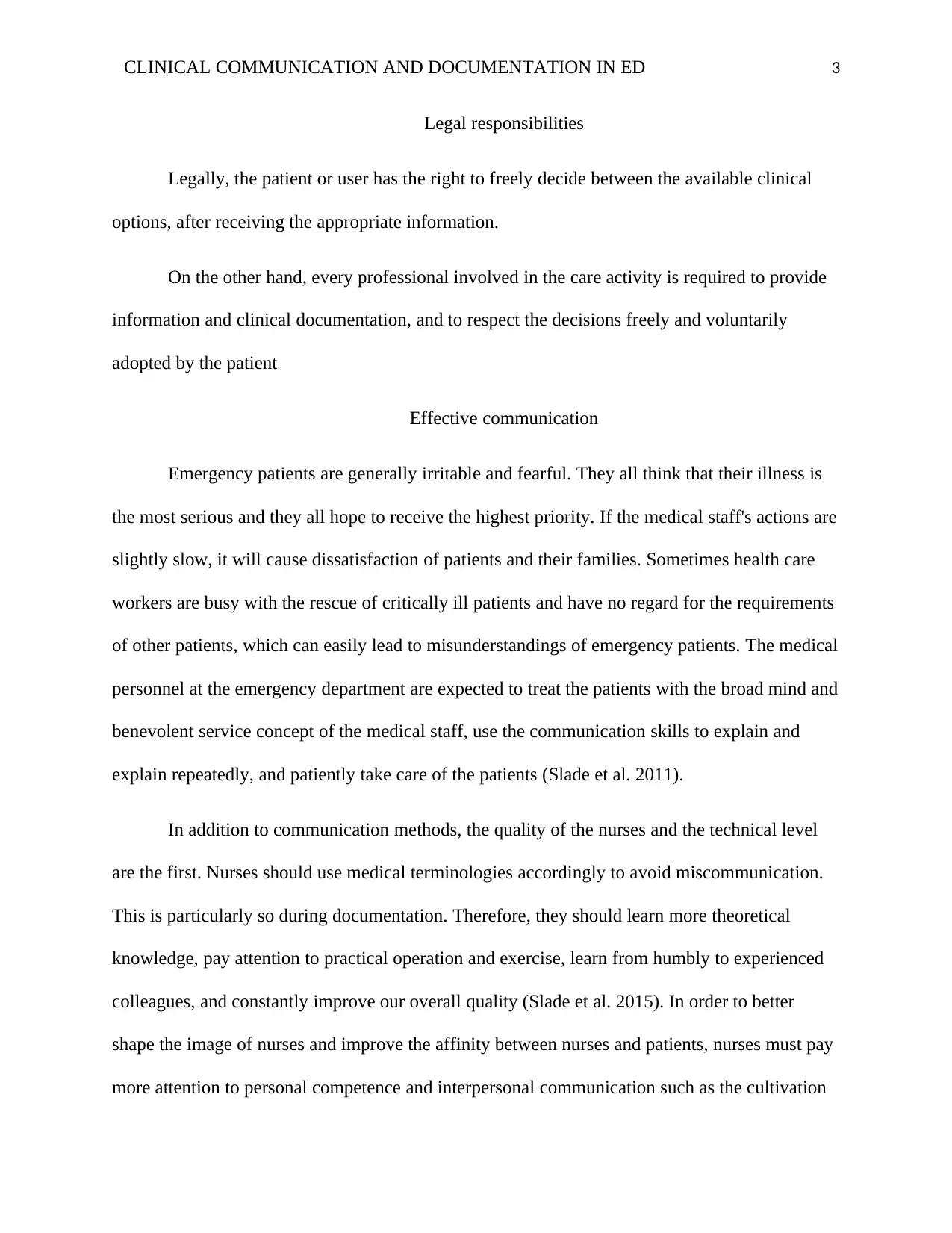
CLINICAL COMMUNICATION AND DOCUMENTATION IN ED 3
Legal responsibilities
Legally, the patient or user has the right to freely decide between the available clinical
options, after receiving the appropriate information.
On the other hand, every professional involved in the care activity is required to provide
information and clinical documentation, and to respect the decisions freely and voluntarily
adopted by the patient
Effective communication
Emergency patients are generally irritable and fearful. They all think that their illness is
the most serious and they all hope to receive the highest priority. If the medical staff's actions are
slightly slow, it will cause dissatisfaction of patients and their families. Sometimes health care
workers are busy with the rescue of critically ill patients and have no regard for the requirements
of other patients, which can easily lead to misunderstandings of emergency patients. The medical
personnel at the emergency department are expected to treat the patients with the broad mind and
benevolent service concept of the medical staff, use the communication skills to explain and
explain repeatedly, and patiently take care of the patients (Slade et al. 2011).
In addition to communication methods, the quality of the nurses and the technical level
are the first. Nurses should use medical terminologies accordingly to avoid miscommunication.
This is particularly so during documentation. Therefore, they should learn more theoretical
knowledge, pay attention to practical operation and exercise, learn from humbly to experienced
colleagues, and constantly improve our overall quality (Slade et al. 2015). In order to better
shape the image of nurses and improve the affinity between nurses and patients, nurses must pay
more attention to personal competence and interpersonal communication such as the cultivation
Legal responsibilities
Legally, the patient or user has the right to freely decide between the available clinical
options, after receiving the appropriate information.
On the other hand, every professional involved in the care activity is required to provide
information and clinical documentation, and to respect the decisions freely and voluntarily
adopted by the patient
Effective communication
Emergency patients are generally irritable and fearful. They all think that their illness is
the most serious and they all hope to receive the highest priority. If the medical staff's actions are
slightly slow, it will cause dissatisfaction of patients and their families. Sometimes health care
workers are busy with the rescue of critically ill patients and have no regard for the requirements
of other patients, which can easily lead to misunderstandings of emergency patients. The medical
personnel at the emergency department are expected to treat the patients with the broad mind and
benevolent service concept of the medical staff, use the communication skills to explain and
explain repeatedly, and patiently take care of the patients (Slade et al. 2011).
In addition to communication methods, the quality of the nurses and the technical level
are the first. Nurses should use medical terminologies accordingly to avoid miscommunication.
This is particularly so during documentation. Therefore, they should learn more theoretical
knowledge, pay attention to practical operation and exercise, learn from humbly to experienced
colleagues, and constantly improve our overall quality (Slade et al. 2015). In order to better
shape the image of nurses and improve the affinity between nurses and patients, nurses must pay
more attention to personal competence and interpersonal communication such as the cultivation
⊘ This is a preview!⊘
Do you want full access?
Subscribe today to unlock all pages.

Trusted by 1+ million students worldwide
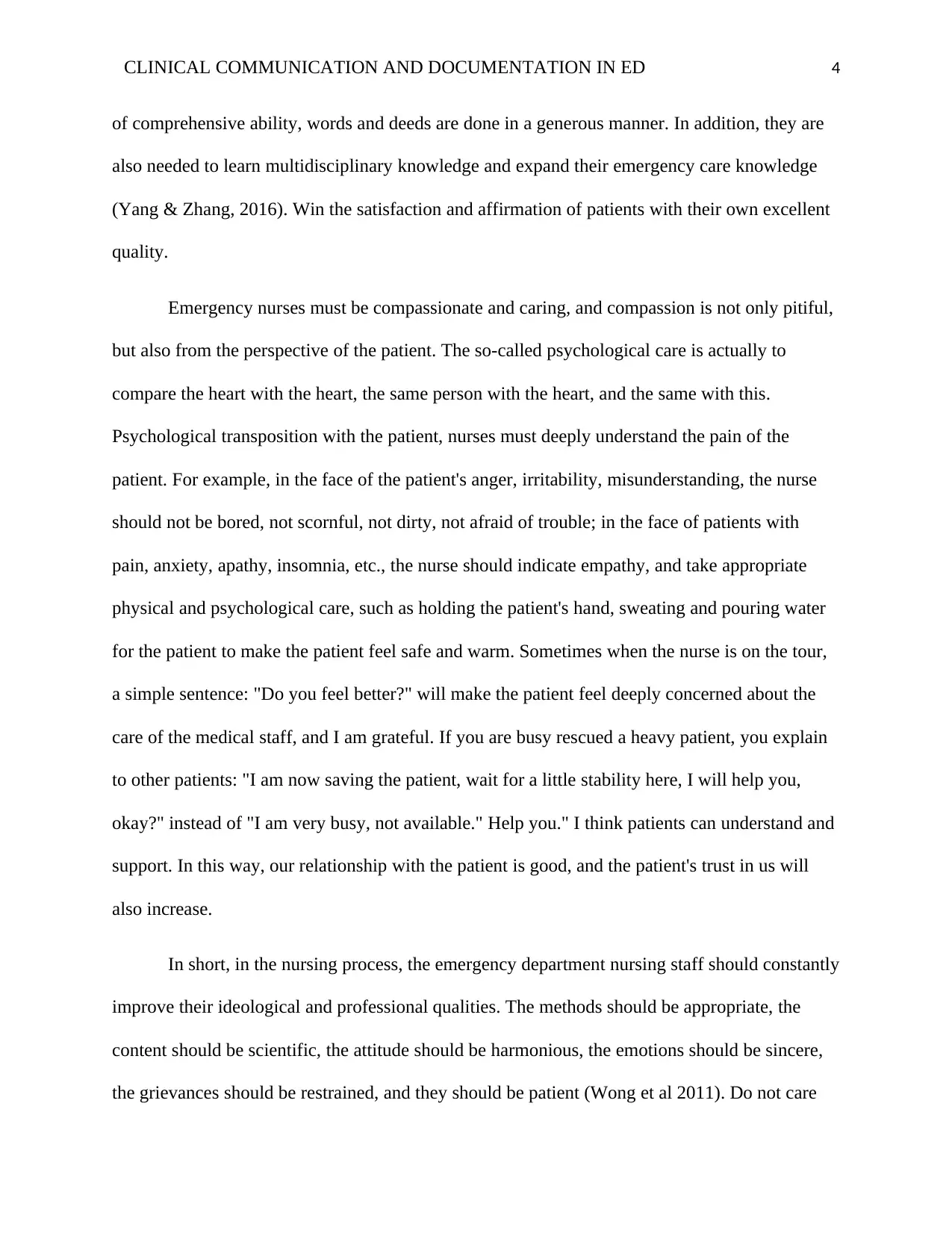
CLINICAL COMMUNICATION AND DOCUMENTATION IN ED 4
of comprehensive ability, words and deeds are done in a generous manner. In addition, they are
also needed to learn multidisciplinary knowledge and expand their emergency care knowledge
(Yang & Zhang, 2016). Win the satisfaction and affirmation of patients with their own excellent
quality.
Emergency nurses must be compassionate and caring, and compassion is not only pitiful,
but also from the perspective of the patient. The so-called psychological care is actually to
compare the heart with the heart, the same person with the heart, and the same with this.
Psychological transposition with the patient, nurses must deeply understand the pain of the
patient. For example, in the face of the patient's anger, irritability, misunderstanding, the nurse
should not be bored, not scornful, not dirty, not afraid of trouble; in the face of patients with
pain, anxiety, apathy, insomnia, etc., the nurse should indicate empathy, and take appropriate
physical and psychological care, such as holding the patient's hand, sweating and pouring water
for the patient to make the patient feel safe and warm. Sometimes when the nurse is on the tour,
a simple sentence: "Do you feel better?" will make the patient feel deeply concerned about the
care of the medical staff, and I am grateful. If you are busy rescued a heavy patient, you explain
to other patients: "I am now saving the patient, wait for a little stability here, I will help you,
okay?" instead of "I am very busy, not available." Help you." I think patients can understand and
support. In this way, our relationship with the patient is good, and the patient's trust in us will
also increase.
In short, in the nursing process, the emergency department nursing staff should constantly
improve their ideological and professional qualities. The methods should be appropriate, the
content should be scientific, the attitude should be harmonious, the emotions should be sincere,
the grievances should be restrained, and they should be patient (Wong et al 2011). Do not care
of comprehensive ability, words and deeds are done in a generous manner. In addition, they are
also needed to learn multidisciplinary knowledge and expand their emergency care knowledge
(Yang & Zhang, 2016). Win the satisfaction and affirmation of patients with their own excellent
quality.
Emergency nurses must be compassionate and caring, and compassion is not only pitiful,
but also from the perspective of the patient. The so-called psychological care is actually to
compare the heart with the heart, the same person with the heart, and the same with this.
Psychological transposition with the patient, nurses must deeply understand the pain of the
patient. For example, in the face of the patient's anger, irritability, misunderstanding, the nurse
should not be bored, not scornful, not dirty, not afraid of trouble; in the face of patients with
pain, anxiety, apathy, insomnia, etc., the nurse should indicate empathy, and take appropriate
physical and psychological care, such as holding the patient's hand, sweating and pouring water
for the patient to make the patient feel safe and warm. Sometimes when the nurse is on the tour,
a simple sentence: "Do you feel better?" will make the patient feel deeply concerned about the
care of the medical staff, and I am grateful. If you are busy rescued a heavy patient, you explain
to other patients: "I am now saving the patient, wait for a little stability here, I will help you,
okay?" instead of "I am very busy, not available." Help you." I think patients can understand and
support. In this way, our relationship with the patient is good, and the patient's trust in us will
also increase.
In short, in the nursing process, the emergency department nursing staff should constantly
improve their ideological and professional qualities. The methods should be appropriate, the
content should be scientific, the attitude should be harmonious, the emotions should be sincere,
the grievances should be restrained, and they should be patient (Wong et al 2011). Do not care
Paraphrase This Document
Need a fresh take? Get an instant paraphrase of this document with our AI Paraphraser
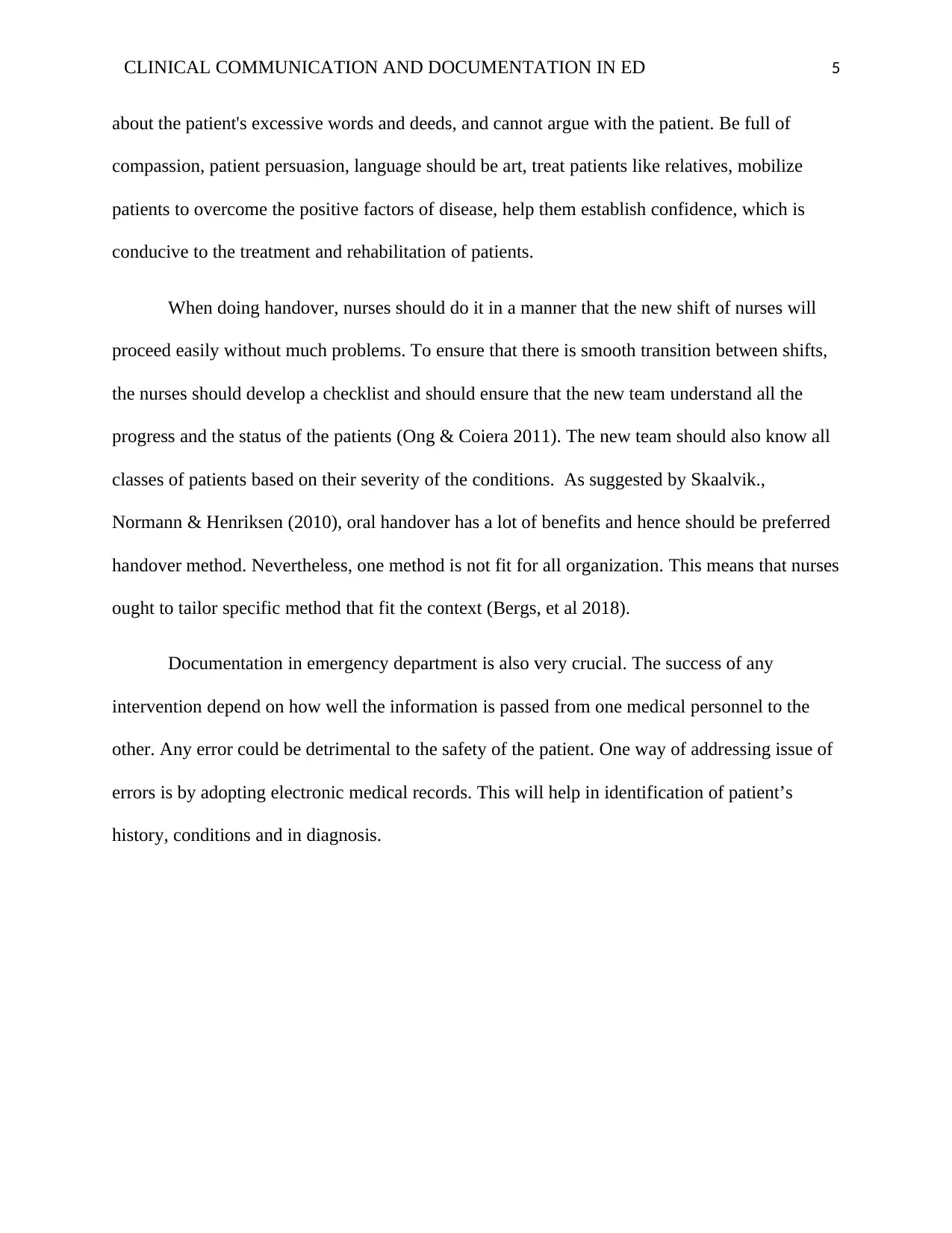
CLINICAL COMMUNICATION AND DOCUMENTATION IN ED 5
about the patient's excessive words and deeds, and cannot argue with the patient. Be full of
compassion, patient persuasion, language should be art, treat patients like relatives, mobilize
patients to overcome the positive factors of disease, help them establish confidence, which is
conducive to the treatment and rehabilitation of patients.
When doing handover, nurses should do it in a manner that the new shift of nurses will
proceed easily without much problems. To ensure that there is smooth transition between shifts,
the nurses should develop a checklist and should ensure that the new team understand all the
progress and the status of the patients (Ong & Coiera 2011). The new team should also know all
classes of patients based on their severity of the conditions. As suggested by Skaalvik.,
Normann & Henriksen (2010), oral handover has a lot of benefits and hence should be preferred
handover method. Nevertheless, one method is not fit for all organization. This means that nurses
ought to tailor specific method that fit the context (Bergs, et al 2018).
Documentation in emergency department is also very crucial. The success of any
intervention depend on how well the information is passed from one medical personnel to the
other. Any error could be detrimental to the safety of the patient. One way of addressing issue of
errors is by adopting electronic medical records. This will help in identification of patient’s
history, conditions and in diagnosis.
about the patient's excessive words and deeds, and cannot argue with the patient. Be full of
compassion, patient persuasion, language should be art, treat patients like relatives, mobilize
patients to overcome the positive factors of disease, help them establish confidence, which is
conducive to the treatment and rehabilitation of patients.
When doing handover, nurses should do it in a manner that the new shift of nurses will
proceed easily without much problems. To ensure that there is smooth transition between shifts,
the nurses should develop a checklist and should ensure that the new team understand all the
progress and the status of the patients (Ong & Coiera 2011). The new team should also know all
classes of patients based on their severity of the conditions. As suggested by Skaalvik.,
Normann & Henriksen (2010), oral handover has a lot of benefits and hence should be preferred
handover method. Nevertheless, one method is not fit for all organization. This means that nurses
ought to tailor specific method that fit the context (Bergs, et al 2018).
Documentation in emergency department is also very crucial. The success of any
intervention depend on how well the information is passed from one medical personnel to the
other. Any error could be detrimental to the safety of the patient. One way of addressing issue of
errors is by adopting electronic medical records. This will help in identification of patient’s
history, conditions and in diagnosis.

CLINICAL COMMUNICATION AND DOCUMENTATION IN ED 6
⊘ This is a preview!⊘
Do you want full access?
Subscribe today to unlock all pages.

Trusted by 1+ million students worldwide
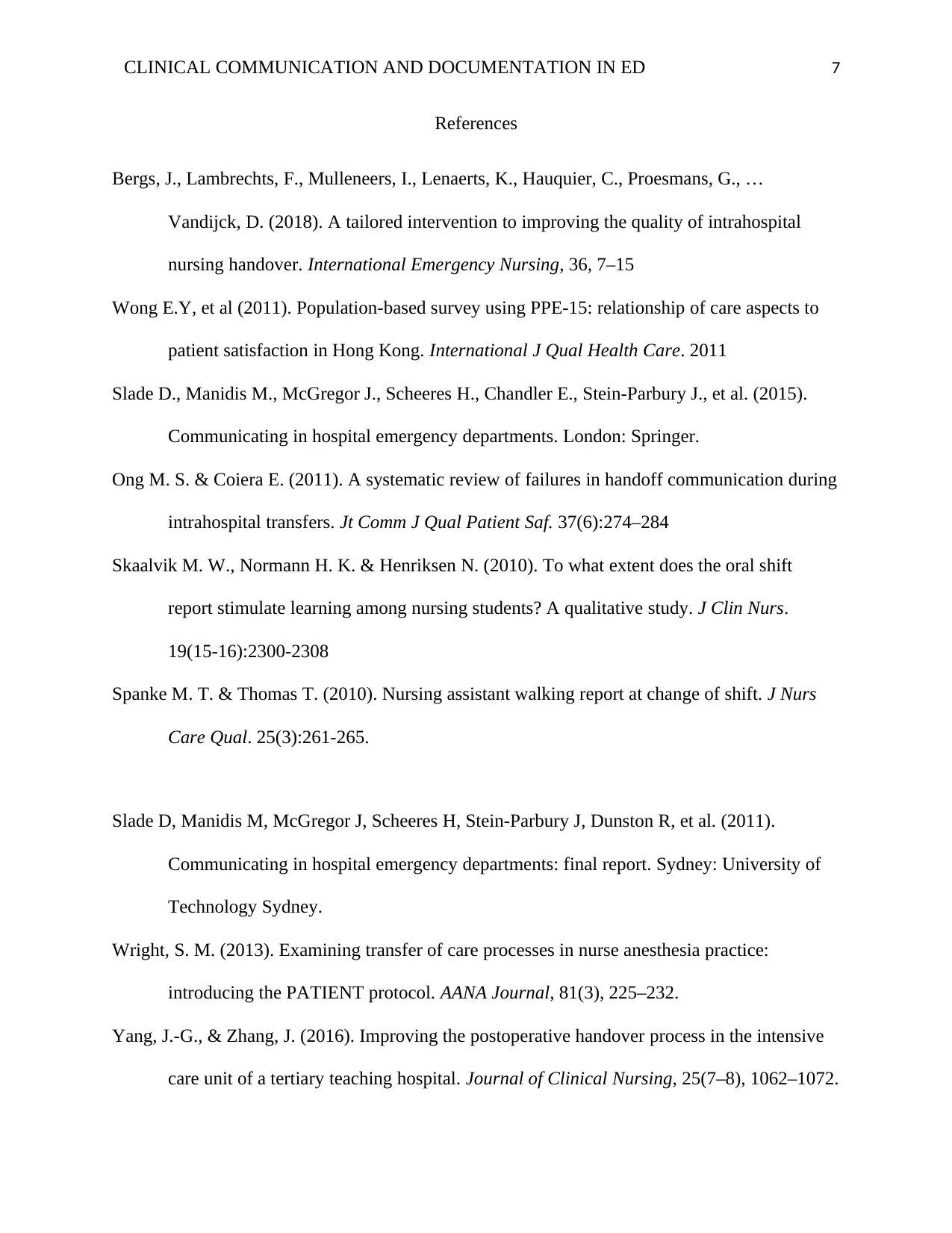
CLINICAL COMMUNICATION AND DOCUMENTATION IN ED 7
References
Bergs, J., Lambrechts, F., Mulleneers, I., Lenaerts, K., Hauquier, C., Proesmans, G., …
Vandijck, D. (2018). A tailored intervention to improving the quality of intrahospital
nursing handover. International Emergency Nursing, 36, 7–15
Wong E.Y, et al (2011). Population-based survey using PPE-15: relationship of care aspects to
patient satisfaction in Hong Kong. International J Qual Health Care. 2011
Slade D., Manidis M., McGregor J., Scheeres H., Chandler E., Stein-Parbury J., et al. (2015).
Communicating in hospital emergency departments. London: Springer.
Ong M. S. & Coiera E. (2011). A systematic review of failures in handoff communication during
intrahospital transfers. Jt Comm J Qual Patient Saf. 37(6):274–284
Skaalvik M. W., Normann H. K. & Henriksen N. (2010). To what extent does the oral shift
report stimulate learning among nursing students? A qualitative study. J Clin Nurs.
19(15-16):2300-2308
Spanke M. T. & Thomas T. (2010). Nursing assistant walking report at change of shift. J Nurs
Care Qual. 25(3):261-265.
Slade D, Manidis M, McGregor J, Scheeres H, Stein-Parbury J, Dunston R, et al. (2011).
Communicating in hospital emergency departments: final report. Sydney: University of
Technology Sydney.
Wright, S. M. (2013). Examining transfer of care processes in nurse anesthesia practice:
introducing the PATIENT protocol. AANA Journal, 81(3), 225–232.
Yang, J.-G., & Zhang, J. (2016). Improving the postoperative handover process in the intensive
care unit of a tertiary teaching hospital. Journal of Clinical Nursing, 25(7–8), 1062–1072.
References
Bergs, J., Lambrechts, F., Mulleneers, I., Lenaerts, K., Hauquier, C., Proesmans, G., …
Vandijck, D. (2018). A tailored intervention to improving the quality of intrahospital
nursing handover. International Emergency Nursing, 36, 7–15
Wong E.Y, et al (2011). Population-based survey using PPE-15: relationship of care aspects to
patient satisfaction in Hong Kong. International J Qual Health Care. 2011
Slade D., Manidis M., McGregor J., Scheeres H., Chandler E., Stein-Parbury J., et al. (2015).
Communicating in hospital emergency departments. London: Springer.
Ong M. S. & Coiera E. (2011). A systematic review of failures in handoff communication during
intrahospital transfers. Jt Comm J Qual Patient Saf. 37(6):274–284
Skaalvik M. W., Normann H. K. & Henriksen N. (2010). To what extent does the oral shift
report stimulate learning among nursing students? A qualitative study. J Clin Nurs.
19(15-16):2300-2308
Spanke M. T. & Thomas T. (2010). Nursing assistant walking report at change of shift. J Nurs
Care Qual. 25(3):261-265.
Slade D, Manidis M, McGregor J, Scheeres H, Stein-Parbury J, Dunston R, et al. (2011).
Communicating in hospital emergency departments: final report. Sydney: University of
Technology Sydney.
Wright, S. M. (2013). Examining transfer of care processes in nurse anesthesia practice:
introducing the PATIENT protocol. AANA Journal, 81(3), 225–232.
Yang, J.-G., & Zhang, J. (2016). Improving the postoperative handover process in the intensive
care unit of a tertiary teaching hospital. Journal of Clinical Nursing, 25(7–8), 1062–1072.
1 out of 7
Related Documents
Your All-in-One AI-Powered Toolkit for Academic Success.
+13062052269
info@desklib.com
Available 24*7 on WhatsApp / Email
![[object Object]](/_next/static/media/star-bottom.7253800d.svg)
Unlock your academic potential
Copyright © 2020–2025 A2Z Services. All Rights Reserved. Developed and managed by ZUCOL.





